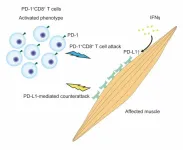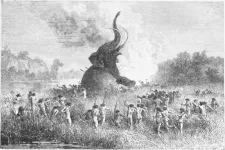(Press-News.org) Artificial Intelligence (AI) and 3D images of the human tongue have revealed that the surface of our tongues are unique to each of us, new findings suggest.
The results offer an unprecedented insight into the biological make-up of our tongue’s surface and how our sense of taste and touch differ from person to person.
The research has huge potential for discovering individual food preferences, developing healthy food alternatives and early diagnosis of oral cancers in the future, experts say.
The human tongue is a highly sophisticated and complex organ. It’s surface is made up of hundreds of small buds – known as papillae – that assist with taste, talking and swallowing.
Of these numerous projections, the mushroom-shaped fungiform papillae hold our taste buds whereas the crown-shaped filiform papillae give the tongue its texture and sense of touch.
The taste function of our fungiform papillae has been well researched but little is known about the difference in shape, size and pattern of both forms of papillae between individuals.
A team of researchers led by the University of Edinburgh’s School of Informatics, in collaboration with the University of Leeds, trained AI computer models to learn from three-dimensional microscopic scans of the human tongue, showing the unique features of papillae.
They fed the data from over two thousand detailed scans of individual papillae – taken from silicone moulds of fifteen people’s tongues – to the AI tool.
The AI models were designed to gain a better understanding of individual features of the participant’s papillae and to predict the age and gender of each volunteer.
The team used small volumes of data to train the AI models about the different features of the papillae, combined with a significant use of topology – an area of mathematics which studies how certain spaces are structured and connected.
This enabled the AI tool to predict the type of papillae to within 85 per cent accuracy and to map the position of filiform and fungiform papillae on the tongue’s surface.
Remarkably, the papillae were also found to be distinctive across all fifteen subjects and individuals could be identified with an accuracy of 48 per cent from a single papilla.
The findings have been published in the journal Scientific Reports:
The study received funding from the United Kingdom Research and Innovation (UKRI) CDT in Biomedical AI and European Research Council (ERC) under the European Union's Horizon 2020 research and innovation program.
Senior author, Professor Rik Sakar, Reader, School of Informatics, University of Edinburgh, said:
“This study brings us closer to understanding the complex architecture of tongue surfaces.
“We were surprised to see how unique these micron-sized features are to each individual. Imagine being able to design personalized food customised to the conditions of specific people and vulnerable populations and thus ensure they can get proper nutrition whilst enjoying their food.
Professor Sakar, added:
“We are now planning to use this technique combining AI with geometry and topology to identify micron-sized features in other biological surfaces. This can help in early detection and diagnosis of unusual growths in human tissues.
Lead author, Rayna Andreeva, PhD student at the Centre for Doctoral Training (CDT) in Biomedical AI, University of Edinburgh, said:
“It was remarkable that the features based on topology worked so well for most types of analysis, and they were the most distinctive across individuals. This needs further study not only for the papillae, but also for other kinds of biological surfaces and medical conditions.”
For further information please contact: Rhona Crawford, Press and PR Office, tel: 07876391498, rhona.crawford@ed.ac.uk
END
AI study reveals individuality of tongue’s surface
Artificial Intelligence (AI) and 3D images of the human tongue have revealed that the surface of our tongues are unique to each of us, new findings suggest
2023-12-14
ELSE PRESS RELEASES FROM THIS DATE:
Finding the source of debilitating, body-wide muscular pain and weakness
2023-12-14
Researchers from Tokyo Medical and Dental University (TMDU) identify the T cells that, when activated, are pathogenic in a subset of idiopathic inflammatory myopathies
Tokyo, Japan – Inflammation is an important part of the body’s defenses, eliminating threats and repairing damage. When the immune system is overactivated, though, it can turn from friend to foe. Now, researchers from Japan have identified the culprit responsible for one type of harmful inflammation that occurs in certain muscular disorders.
In a study published last month in the Journal of Autoimmunity, ...
Jacob Tsimerman receives Ostrowski Prize in Higher Mathematics
2023-12-14
The Canadian mathematician Jacob Tsimerman has been awarded the International Ostrowski Prize in Higher Mathematics 2023. The Ostrowski Prize is worth 100,000 Swiss Francs and named after Alexander M. Ostrowski, a professor of mathematics who taught at the University of Basel.
Jacob Tsimerman, a professor of mathematics at the University of Toronto (Canada), received the Ostrowski Prize 2023 in recognition of his work at the interface of transcendence theory, analytic number theory and arithmetic geometry, including recent breakthroughs on the André-Oort and Griffiths conjectures.
Shimura varieties are algebraic varieties of great ...
This next generation blue light could potentially promote or hinder sleep on command
2023-12-14
Blue light from LED lamps and consumer electronics can mess with your sleep because it disrupts production of the natural sleep hormone melatonin. Tinted glasses or displays in night mode can mask, but don’t remove, a portion of the disruptive wavelengths. But now, researchers report in ACS Omega that they have designed more “human-centric” LEDs that could potentially enhance drowsiness or alertness on command.
Humans have evolved over millennia to be active during the day and to rest at night; we’ve depended on the sun to regulate our sleep/wake cycle. But many people ...
New app to bridge information gap between hospitals and nursing homes; better care for patients
2023-12-14
INDIANAPOLIS – Approximately one in five older adults in the U.S. is transferred to a nursing home following a hospital stay. For many of these patients, an accessible medical record does not accompany them, often negatively affecting the care they receive at the nursing home. This poor information sharing is a significant problem contributing to the adverse events within 45 days of hospital discharge experienced by nearly 40 percent of nursing home residents.
Regenstrief Institute research scientists Kathleen Unroe, M.D., MHA, and Joshua Vest, PhD, ...
Timothy Rhoads of the University of Wisconsin Madison receives the AFAR 2023 Sagol Network GerOmic Award for Junior Faculty
2023-12-14
NEW YORK — The American Federation for Aging Research (AFAR) is pleased to announce recipient of the 2023 Sagol Network GerOmic Award for Junior Faculty: Timothy Rhoads, PhD, Assistant Professor, University of Wisconsin-Madison. Established in 2020, the Sagol Network GerOmic Award for Junior Faculty is a one- to two-year award given to junior faculty (MDs and PhDs) to conduct aging-related Omics (GerOmics) research.
Omics is a rapidly evolving, multi-disciplinary, and emerging field that encompasses genomics, epigenomics, transcriptomics, proteomics, and metabolomics. Each of these fields offers ...
American Meteorological Society Announces David J. Stensrud as New President-Elect
2023-12-14
[Boston, MA—December 13, 2023] Members of the American Meteorological Society (AMS)—composed of weather, water, and climate professionals—have voted to elect David J. Stensrud to the position of President-Elect for 2024. He will be inducted to the post Sunday, 28 January, 2024, during the 104th AMS Annual Meeting in Baltimore, Maryland.
The AMS will also induct five new Councilors at the 2024 Annual Meeting. Cynthia Atherton, Gina Eosco, Andrew Humphrey, Ying-Hwa (Bill) Kuo, and Clifford Mass have been selected to serve three-year ...
Being overweight costs society far more than obesity
2023-12-14
“We often hear that obesity represents a high cost for both individuals and society because it increases the risk of health problems. All in all, however, the costs associated with being overweight are much higher,” says Christina Hansen Edwards, a researcher at the Norwegian University of Science and Technology (NTNU).
Since the 1980s, Norwegians have become increasingly heavier. Over the past 40 years, the percentage of people with obesity, i.e. a body mass index (BMI) of over 30, has increased significantly. It is currently estimated that almost one in four Norwegians is obese, ...
People, not the climate, caused the decline of the giant mammals
2023-12-14
About 100,000 years ago, the first modern humans migrated out of Africa in large numbers. They were eminent at adapting to new habitats, and they settled in virtually every kind of landscape - from deserts to jungles to the icy taiga in the far north.
Part of the success was human's ability to hunt large animals. With clever hunting techniques and specially built weapons, they perfected the art of killing even the most dangerous mammals.
But unfortunately, the great success of our ancestors came at the expense of the other large mammals.
It is well-known that numerous large species went extinct ...
Children who are sedentary may have a higher risk of heart attack or stroke later in life
2023-12-14
WASHINGTON—Children who are physically inactive may have high cholesterol in early adulthood and subsequent heart health issues in their mid-forties, according to new research published in The Journal of Clinical Endocrinology & Metabolism.
High cholesterol during childhood has been associated with early signs of heart disease when individuals reach their mid-twenties and an increased risk of premature cardiovascular death in their mid-forties. Several clinical trials aimed at lowering cholesterol levels in the youth population have had minimal ...
Cockroaches can transmit antimicrobial resistance genes between groups
2023-12-14
Washington, D.C.—A new paper describes a study of antimicrobial resistance (AMR) transmission among cockroaches, with implications for AMR transmission in humans. The study was published in mSystems, a journal of the American Society for Microbiology.
AMR represents a serious threat to the health of humans and other animals. With fewer and fewer drugs being effective against some microbial pathogens, infections have become increasingly difficult to treat. Theoretical modeling has been used to explore the spread of AMR through the microbiome of the symbiotic, or nonpathogenic, gut of animals. The present study ...
LAST 30 PRESS RELEASES:
Report on academic exchange (colloquium) with Mapua University
Sport in middle childhood can breed respect for authority in adolescence
From novel therapies to first-in-human trials, City of Hope advances blood cancer care at the American Society of Hematology (ASH) annual conference
Research aims to strengthen the security of in-person voting machines
New study exposes hidden Alzheimer’s 'hot spots' in rural Maryland and what they reveal about America’s growing healthcare divide
ASH 2025: Study connects Agent Orange exposure to earlier and more severe cases of myelodysplastic syndrome
ASH 2025: New data highlights promise of pivekimab sunirine in two aggressive blood cancers
IADR elects George Belibasakis as vice-president
Expanding the search for quantum-ready 2D materials
White paper on leadership opportunities for AI to increase employee value released by University of Phoenix College of Doctoral Studies
ASH 2025: New combination approach aims to make CAR T more durable in lymphoma
‘Ready-made’ T-cell gene therapy tackles ‘incurable’ T-cell leukemia
How brain activity changes throughout the day
Australian scientists reveal new genetic risk for severe macular degeneration
GLP-1 receptor agonists likely have little or no effect on obesity-related cancer risk
Precision immunotherapy to improve sepsis outcomes
Insilico Medicine unveils winter edition of Pharma.AI, accelerating the path to pharmaceutical superintelligence
Study finds most people trust doctors more than AI but see its potential for cancer diagnosis
School reopening during COVID-19 pandemic associated with improvement in children’s mental health
Research alert: Old molecules show promise for fighting resistant strains of COVID-19 virus
Journal of Nuclear Medicine Technology supplement highlights advances in theranostics and opportunities for growth
New paper rocks earthquake science with a clever computational trick
ASH 2025: Milder chemo works for rare, aggressive lymphoma
Olfaction written in bones: New insights into the evolution of the sense of smell in mammals
Engineering simulations rewrite the timeline of the evolution of hearing in mammals
New research links health impacts related to 'forever chemicals' to billions in economic losses
Unified EEG imaging improves mapping for epilepsy surgery
$80 million in donations propels UCI MIND toward world-class center focused on dementia
Illinois research uncovers harvest and nutrient strategies to boost bioenergy profits
How did Bronze Age plague spread? A sheep might solve the mystery
[Press-News.org] AI study reveals individuality of tongue’s surfaceArtificial Intelligence (AI) and 3D images of the human tongue have revealed that the surface of our tongues are unique to each of us, new findings suggest




